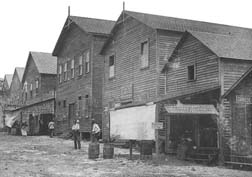This article needs additional citations for verification. (August 2014) |

| History of Florida |
|---|
 |
|
|
Thousands of years before Europeans arrived, a large portion of south east Florida, including the area where Miami, Florida exists today, was inhabited by Tequestas. The Tequesta (also Tekesta, Tegesta, Chequesta, Vizcaynos) Native American tribe, at the time of first European contact, occupied an area along the southeastern Atlantic coast of Florida. They had infrequent contact with Europeans and had largely migrated by the middle of the 18th century. Miami is named after the Mayaimi, a Native American tribe that lived around Lake Okeechobee until the 17th or 18th century.
The Spanish established a mission and small garrison among the Tequesta on Biscayne Bay in 1567. The mission and garrison were withdrawn a couple of years later.[2] In 1743 the governor of Cuba established another mission and garrison on Biscayne Bay. As the mission had not been approved by the Council of the Indies, the mission and garrison were withdrawn the following year. The Spanish recorded that the inhabitants at the site of the 1743 mission were survivors of the Cayos, Carlos (presumed to be Caloosa) and Boca Raton people, who were subject to periodic raids by the Uchises (native allies of the English in South Carolina).[3] Fort Dallas was built in 1836 and functioned as a military base during the Second Seminole War.[4]
The Miami area was better known as "Biscayne Bay Country" in the early years of its growth. The few published accounts from that period describe the area as a wilderness that held much promise.[5] The area was also characterized as "one of the finest building sites in Florida".[5] After the Great Freeze of 1894, the crops of the Miami area were the only ones in Florida that survived. Julia Tuttle, a local landowner, convinced Henry Flagler, a railroad tycoon, to expand his Florida East Coast Railway to Miami. On July 28, 1896, Miami was officially incorporated as a city with a population of just over 300.[6]
Miami prospered during the 1920s, but weakened when the real-estate bubble burst in 1925, which was shortly followed by the 1926 Miami Hurricane and the Great Depression in the 1930s. When World War II began, Miami played an important role in the battle against German submarines due to its location on the southern coast of Florida. The war helped to increase Miami's population to almost half a million. After Fidel Castro rose to power in 1959, many Cubans emigrated to Miami, further increasing the population. In the 1980s and 1990s, various crises struck South Florida, among them the Arthur McDuffie beating and the subsequent riot, drug wars, Hurricane Andrew, and the Elián González affair. Despite these, Miami remains a major international, financial, and cultural center.
The city's name is derived from the Miami River, which is ultimately derived from the Mayaimi people who lived in the area at the time of European colonization.
Though spelled the same in English, the Florida city's name has nothing to do with the Miami people who lived in a completely different part of North America.
- ^ Wiggins, Larry (1995). "The Birth of the City of Miami" (PDF). Tequesta 1995 page 29. HistoryMiami. Retrieved February 9, 2014.
- ^ McNicoll, Robert E. (1941). "The Caloosa Village Tequesta: A Miami of the Sixteenth Century" (PDF). Tequesta. 1: 14, 17. Archived from the original (PDF) on September 10, 2016. Retrieved January 30, 2021 – via Florida International University Digital Collections.
- ^ Sturtevant, William C. (1978). "The Last of the South Florida Aborigines". In Milanich, Jerald T.; Proctor, Samual (eds.). Tacachale. Gainesville, Florida: The University Presses of Florida. pp. 144–147. ISBN 0-8130-0535-3.
- ^ George, Paul. "Miami: One Hundred Years of History: The Seminole Wars". Historical Museum of Southern Florida. Archived from the original on July 3, 2008. Retrieved August 24, 2009.
- ^ a b Wiggins, Larry. "The Birth of the City of Miami". Historical Museum of Southern Florida. Archived from the original on September 21, 2007.
- ^ George, Paul S. "Miami is Born". Archived from the original on July 3, 2008. Retrieved August 24, 2009.